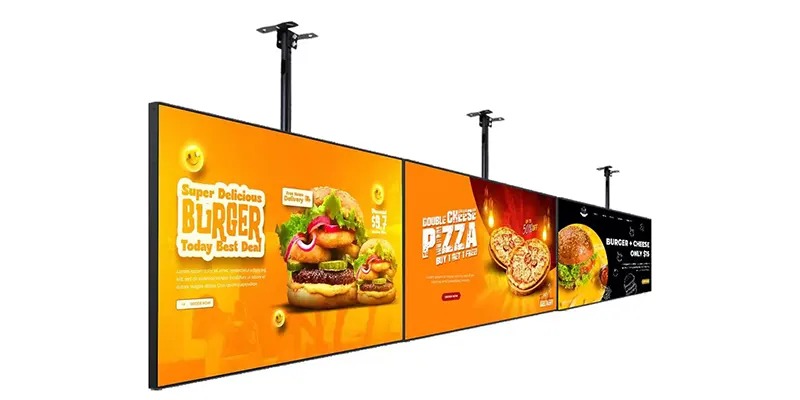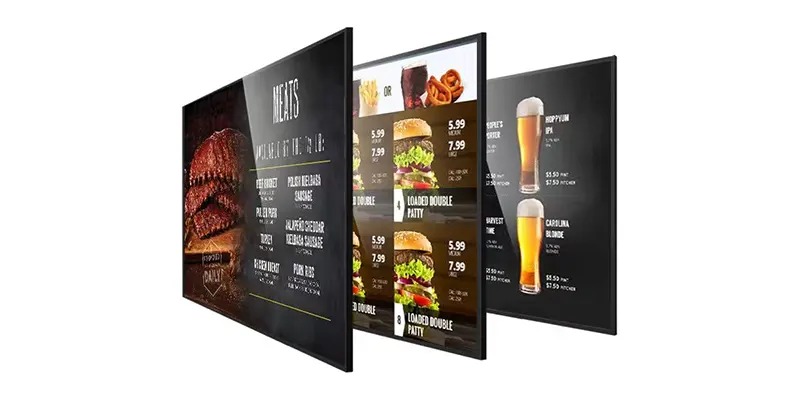Do Customers Prefer Restaurant Menu Digital Signage?
Walk into any modern restaurant today, and you’ll likely see glowing restaurant menu digital signage instead of printed menus. These screens are eye-catching, easy to update, and part of a growing digital shift in the food industry. But are they just a trendy upgrade, or do customers genuinely prefer them? Let’s explore how digital menus impact customer experience and why they’re changing the way we order food.

Understanding Restaurant Menu Digital Signage
Restaurant menu digital signage are electronic displays that show a restaurant’s menu in a dynamic, visually appealing format. Unlike static boards or paper menus, these can include videos, animations, and live updates.
They’re typically powered by software that allows restaurants to change pricing, highlight promotions, or switch to breakfast menus — all with a few clicks.
The Psychology Behind Menu Design
Humans are visual creatures. Research shows that we make food choices within seconds of seeing an image. A vibrant picture of a burger sizzling on screen can be far more persuasive than a printed list of ingredients.
Colors, motion, and layout play big roles here — reds and yellows evoke hunger, while gentle motion draws attention to premium items.
Advantages of Restaurant Menu Digital Signage
1. Real-Time Updates and Flexibility
Need to change prices, remove an out-of-stock item, or launch a special? No reprints, no downtime. Digital boards make that instant and effortless.
2. Cost-Efficiency Over Time
While initial installation might be expensive, businesses save on printing and labor costs in the long run.
3. Enhanced Visual Appeal
High-resolution images, videos, and motion grab attention, increasing engagement — and often, sales.
4. Better Upselling Opportunities
Restaurants can promote combos, limited-time offers, or new items in real-time, nudging customers toward higher-value choices.
Customer Experience and Engagement
Customers often describe digital menus as easier to read and more engaging. Bright visuals help them quickly identify what they want. Some digital boards even allow for interactive experiences, letting customers browse nutritional info or customize orders.
In short: digital menus aren’t just displays — they’re experiences.
Impact on Quick Service Restaurants (QSRs)
Fast-food chains like McDonald’s, Subway, and Starbucks have embraced digital menu boards for speed and consistency. For example, McDonald’s uses them to switch seamlessly between breakfast and lunch menus, improving service flow and reducing confusion.
Do Customers Actually Prefer Restaurant Menu Digital Signage?

Surveys suggest around 70% of customers prefer digital boards because they’re easier to read and more attractive. However, preference varies:
Younger audiences appreciate tech-driven solutions.
Older customers may still prefer simpler, static menus.
Overall, digital menus tend to enhance satisfaction, particularly when designed intuitively.
The Role of Restaurant Menu Digital Signage in Modern Branding
One of the biggest advantages of digital menu boards is the ability to collect and analyze data in real time. Every customer interaction — from what items get the most attention to which promotions drive the highest sales — can be tracked and measured.
With these insights, restaurants can fine-tune their menus, highlight best-sellers, and even test new dishes with minimal risk. Analytics also reveal peak order times, customer preferences, and seasonal trends, helping businesses adjust pricing, inventory, and marketing strategies accordingly.
In short, digital menu boards aren’t just tools for display — they’re smart business assets that turn every order into valuable data for better decisions.
Challenges of Implementing Restaurant Menu Digital Signage
No system is perfect. The main hurdles include:
High upfront costs for screens and software
Technical issues like connectivity or display errors
Constant need for content updates to keep things fresh
Businesses that plan ahead and invest in maintenance usually overcome these easily.
Digital Menu Boards vs. Static Menu Boards
| Feature | Restaurant Menu Digital Signage | Static Menu Board |
|---|---|---|
| Flexibility | Instant updates | Requires reprinting |
| Visuals | Dynamic and animated | Static images |
| Cost (Long-Term) | Lower | Higher due to printing |
| Customer Engagement | High | Moderate |
Digital wins for flexibility and engagement, but small cafés might still favor the simplicity of traditional boards.
The Role of Analytics in Digital Menus
Digital menu software often includes analytics tools that track what customers order most, what promotions perform best, and what content drives conversions. This data helps restaurants make data-driven menu decisions.
Integrating AI and Automation
AI is making digital menus smarter. Imagine a screen that recognizes repeat customers and displays their favorite meals or current deals. Some systems even adjust pricing dynamically based on demand — a glimpse of the future!
The Future of Restaurant Menu Digital Signage
Expect integration with mobile apps, voice assistants, and even augmented reality menus where you can visualize dishes before ordering. As technology grows, digital boards will become even more immersive and efficient.
Real-World Examples of Success
Starbucks: Uses digital menus to promote seasonal drinks effectively.
McDonald’s: Adjusts displays automatically based on time of day.
Dunkin’: Personalizes digital content by location and weather.
Each of these brands proves that smart digital menu use equals better engagement and higher sales.
Conclusion
So, do customers prefer digital menu boards? The answer is largely yes — especially when they’re done right. They’re visually engaging, efficient, and aligned with how people interact with technology today.
Still, the best approach blends technology with a human touch — ensuring that innovation enhances, not replaces, hospitality.
FAQs
1. Are digital menu boards expensive to install?
Yes, the initial investment can be high, but the long-term savings on printing and updates make them cost-effective.
2. Can digital menus help increase sales?
Absolutely. Bright visuals and dynamic promotions often lead to higher average order values.
3. Do older customers struggle with digital menu boards?
Some may, but intuitive design and clear visuals help minimize confusion.
4. Are digital menus eco-friendly?
Yes — they reduce paper waste and support sustainability goals.
5. What’s the future of digital menu boards?
Expect AI integration, personalization, and AR-driven customer experiences to redefine how we view menus.
